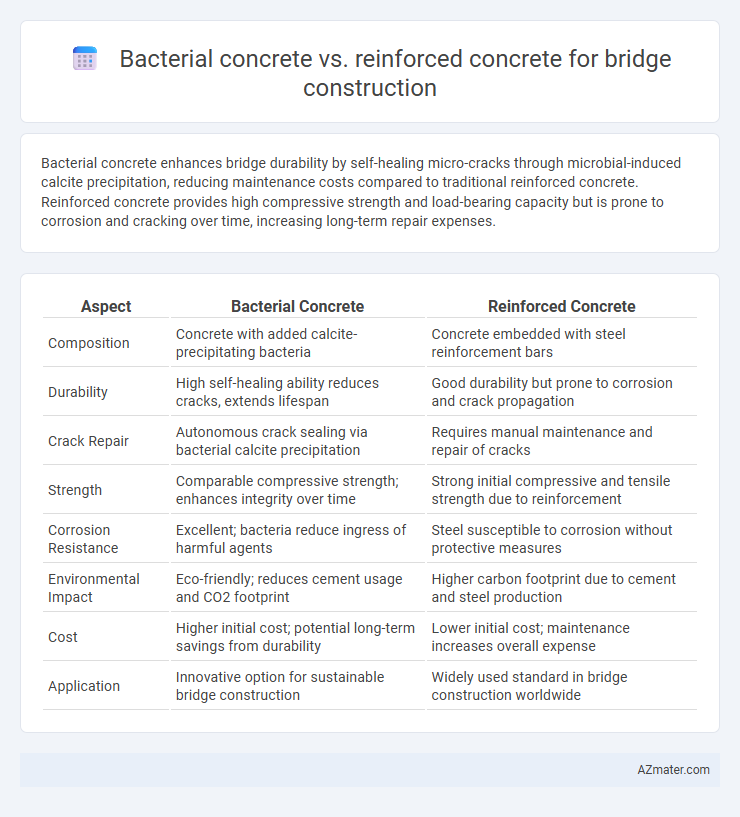Bacterial concrete enhances bridge durability by self-healing micro-cracks through microbial-induced calcite precipitation, reducing maintenance costs compared to traditional reinforced concrete. Reinforced concrete provides high compressive strength and load-bearing capacity but is prone to corrosion and cracking over time, increasing long-term repair expenses.
Table of Comparison
| Aspect | Bacterial Concrete | Reinforced Concrete |
|---|---|---|
| Composition | Concrete with added calcite-precipitating bacteria | Concrete embedded with steel reinforcement bars |
| Durability | High self-healing ability reduces cracks, extends lifespan | Good durability but prone to corrosion and crack propagation |
| Crack Repair | Autonomous crack sealing via bacterial calcite precipitation | Requires manual maintenance and repair of cracks |
| Strength | Comparable compressive strength; enhances integrity over time | Strong initial compressive and tensile strength due to reinforcement |
| Corrosion Resistance | Excellent; bacteria reduce ingress of harmful agents | Steel susceptible to corrosion without protective measures |
| Environmental Impact | Eco-friendly; reduces cement usage and CO2 footprint | Higher carbon footprint due to cement and steel production |
| Cost | Higher initial cost; potential long-term savings from durability | Lower initial cost; maintenance increases overall expense |
| Application | Innovative option for sustainable bridge construction | Widely used standard in bridge construction worldwide |
Introduction to Bridge Construction Materials
Bacterial concrete incorporates bio-mineralization processes using microorganisms to enhance durability and self-healing properties, reducing crack formation and corrosion in bridge structures. Reinforced concrete, a traditional material comprising concrete embedded with steel reinforcement bars, offers high compressive strength and tensile resistance suitable for load-bearing bridge components. The selection between bacterial and reinforced concrete depends on factors such as environmental conditions, maintenance requirements, and long-term structural performance essential for bridge construction.
Overview of Reinforced Concrete
Reinforced concrete is a composite material consisting of concrete embedded with steel reinforcement bars to enhance tensile strength and durability for bridge construction. It offers high compressive strength, resistance to environmental factors, and the ability to support heavy loads, making it ideal for large-scale infrastructure projects. The integration of reinforcement addresses concrete's natural brittleness, ensuring structural stability and longevity in bridges.
Fundamentals of Bacterial Concrete Technology
Bacterial concrete utilizes microbial-induced calcite precipitation (MICP) to heal cracks and enhance durability, fundamentally differing from traditional reinforced concrete, which relies on steel reinforcement for tensile strength. The bacteria, often Bacillus species, are embedded within the concrete matrix and activate upon crack formation, precipitating calcium carbonate to seal fissures autonomously. This bio-based self-healing mechanism significantly reduces maintenance costs and extends bridge lifespan by minimizing micro-crack propagation and corrosion of reinforcements.
Strength and Durability Comparison
Bacterial concrete exhibits enhanced crack resistance and self-healing properties due to microbial-induced calcite precipitation, resulting in improved long-term durability compared to traditional reinforced concrete. Reinforced concrete offers high initial compressive and tensile strength through steel reinforcement but is susceptible to corrosion and cracking over time, reducing its lifespan. In bridge construction, bacterial concrete's ability to autonomously repair microcracks extends structural integrity, while reinforced concrete requires regular maintenance to sustain strength and durability under environmental stressors.
Crack Resistance and Self-Healing Properties
Bacterial concrete enhances crack resistance and self-healing properties through the incorporation of specific bacteria that precipitate calcium carbonate, effectively sealing micro-cracks and reducing permeability in bridge structures. Reinforced concrete, while strong under tensile and compressive loads due to steel reinforcement, lacks intrinsic self-healing capabilities and requires maintenance for crack repairs to prevent structural degradation. The use of bacterial concrete in bridge construction improves durability and reduces long-term maintenance costs by autonomously repairing cracks, which is critical for sustaining load-bearing capacity and extending service life.
Environmental Impact and Sustainability
Bacterial concrete enhances bridge construction sustainability by reducing carbon dioxide emissions through self-healing properties that extend structural lifespan, minimizing the need for frequent repairs and raw material consumption. Reinforced concrete, while offering high strength, relies heavily on steel production, contributing significantly to greenhouse gas emissions and resource depletion. Incorporating bacterial concrete technologies in bridges promotes eco-friendly infrastructure by leveraging microbial-induced calcite precipitation, ultimately lowering environmental impact compared to traditional reinforced concrete.
Cost Analysis and Economic Considerations
Bacterial concrete reduces long-term maintenance costs for bridge construction through self-healing properties that minimize cracks and structural repairs, potentially lowering lifecycle expenses compared to conventional reinforced concrete. Initial material costs for bacterial concrete tend to be higher, but the extended durability and reduced repair frequency offer significant economic benefits over years of service. Economic considerations favor bacterial concrete in large-scale projects where reduced downtime and enhanced longevity translate into substantial cost savings and improved asset management.
Maintenance Needs and Lifecycle Performance
Bacterial concrete enhances bridge construction by reducing maintenance needs through self-healing properties that seal microcracks and prevent corrosion, extending the structure's lifecycle performance. Reinforced concrete, while durable, often requires frequent inspections, crack repairs, and corrosion control measures, leading to higher maintenance costs over time. Lifecycle assessments demonstrate bacterial concrete's superior long-term durability and cost-effectiveness by minimizing degradation and enhancing structural resilience.
Case Studies: Practical Applications in Bridges
Bacterial concrete enhances bridge durability by self-healing microcracks, reducing maintenance costs and extending lifespan in case studies such as the Indian Viaduct and Dutch Highway Bridge. Reinforced concrete remains the standard for load-bearing capacity and structural integrity, evidenced by multiple successful projects like the Golden Gate Bridge retrofit and Australia's Sydney Harbour Bridge maintenance. Practical applications reveal bacterial concrete's potential for sustainability and resilience, while reinforced concrete ensures proven mechanical strength in bridge construction.
Future Prospects and Research Directions
Bacterial concrete offers promising future prospects in bridge construction due to its self-healing properties, which significantly reduce maintenance costs and enhance durability by autonomously repairing micro-cracks. Research is increasingly focusing on optimizing bacterial strains, nutrient delivery methods, and environmental resilience to improve the material's performance under diverse climatic conditions and loading scenarios. Advancements in integrating bacterial concrete with traditional reinforced concrete structures aim to create hybrid systems that combine structural strength with longevity and sustainability.

Infographic: Bacterial concrete vs Reinforced concrete for Bridge construction
 azmater.com
azmater.com